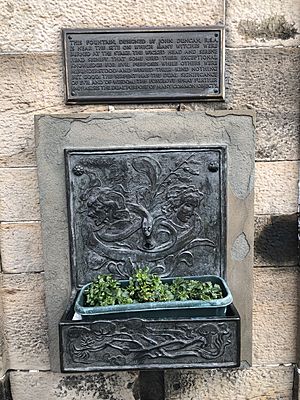Witches' Well, Edinburgh facts for kids
 |
|
| Location | Castle Esplanade, Edinburgh, Scotland |
|---|---|
| Designer | John Duncan (painter) |
| Dedicated to | Witches burned at the stake nearby during the period 1479–1722 |
The Witches' Well is a special monument in Edinburgh, Scotland. It remembers people who were accused of being witches and sadly lost their lives a long time ago. This well is the only one of its kind in Edinburgh.
It's a drinking fountain attached to a wall near Edinburgh Castle. It's close to where many of these accused people were executed. During a time when many people were accused of witchcraft, a lot of them came from the area around Edinburgh.
About the Witches' Well
The Witches' Well was created by Sir Patrick Geddes in 1894. His friend, John Duncan, designed it. The well has a bronze picture showing a foxglove plant. A snake is wrapped around the heads of Hygeia, the Greek goddess of good health, and her father Aesculapius, the god of medicine.
Other parts of the well show trees, healing hands, and an "evil eye." The water spout, which is now dry, is under the snake's head. You can see the Roman numerals for 1479 and 1722 on the well. These dates show the time when most people were accused of witchcraft in Scotland. A model of the well is kept at the City Art Centre in Edinburgh.
History of the Location
The building where the well is attached was built in 1851. It used to be part of the Castlehill Reservoir, which held fresh water for the city. Before that, an older building from the 1600s stood there. This older building helped bring water from the Pentland Hills to Edinburgh.
The reservoir connected to 12 wells around the city. It stopped being used in 1992. In 1996, the building became the Tartan Weaving Mill, which it is today.
Many people have asked for a new, lasting memorial for those who were accused. Groups like Edinburgh World Heritage and experts from universities have supported this idea. They want to make sure these people are remembered properly.
The Special Plaque
A plaque was placed above the fountain in 1912. It explains a bit about the well. The words on the plaque say that the well is near where many accused witches were executed. It also talks about the meaning of the symbols.
The plaque says that the "wicked head" and "serene head" mean some people used their knowledge for bad, while others were misunderstood. It also says the snake means both evil and wisdom. The foxglove plant shows that many common things can have a dual purpose. However, some people have said the plaque's words are not fully accurate. This is because they suggest the accused people actually had magical powers.
Images for kids



